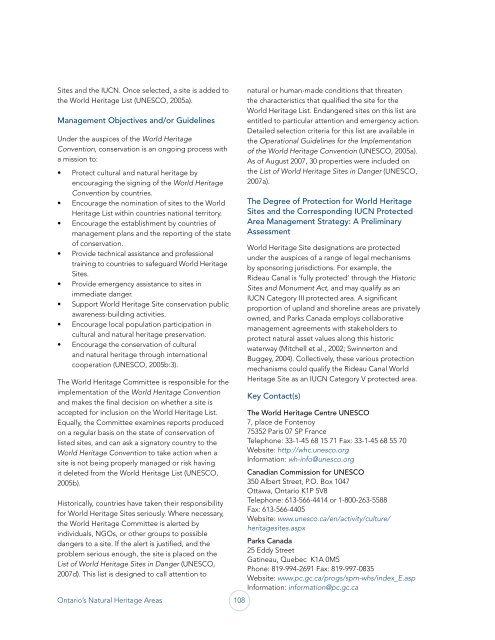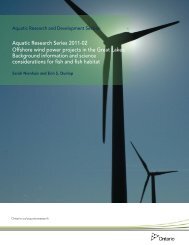Ontario's Natural Heritage Areas - Ministry of Natural Resources
Ontario's Natural Heritage Areas - Ministry of Natural Resources
Ontario's Natural Heritage Areas - Ministry of Natural Resources
You also want an ePaper? Increase the reach of your titles
YUMPU automatically turns print PDFs into web optimized ePapers that Google loves.
Sites and the IUCN. Once selected, a site is added to<br />
the World <strong>Heritage</strong> List (UNESCO, 2005a).<br />
Management Objectives and/or Guidelines<br />
Under the auspices <strong>of</strong> the World <strong>Heritage</strong><br />
Convention, conservation is an ongoing process with<br />
a mission to:<br />
• Protect cultural and natural heritage by<br />
encouraging the signing <strong>of</strong> the World <strong>Heritage</strong><br />
Convention by countries.<br />
• Encourage the nomination <strong>of</strong> sites to the World<br />
<strong>Heritage</strong> List within countries national territory.<br />
• Encourage the establishment by countries <strong>of</strong><br />
management plans and the reporting <strong>of</strong> the state<br />
<strong>of</strong> conservation.<br />
• Provide technical assistance and pr<strong>of</strong>essional<br />
training to countries to safeguard World <strong>Heritage</strong><br />
Sites.<br />
• Provide emergency assistance to sites in<br />
immediate danger.<br />
• Support World <strong>Heritage</strong> Site conservation public<br />
awareness-building activities.<br />
• Encourage local population participation in<br />
cultural and natural heritage preservation.<br />
• Encourage the conservation <strong>of</strong> cultural<br />
and natural heritage through international<br />
cooperation (UNESCO, 2005b:3).<br />
The World <strong>Heritage</strong> Committee is responsible for the<br />
implementation <strong>of</strong> the World <strong>Heritage</strong> Convention<br />
and makes the final decision on whether a site is<br />
accepted for inclusion on the World <strong>Heritage</strong> List.<br />
Equally, the Committee examines reports produced<br />
on a regular basis on the state <strong>of</strong> conservation <strong>of</strong><br />
listed sites, and can ask a signatory country to the<br />
World <strong>Heritage</strong> Convention to take action when a<br />
site is not being properly managed or risk having<br />
it deleted from the World <strong>Heritage</strong> List (UNESCO,<br />
2005b).<br />
Historically, countries have taken their responsibility<br />
for World <strong>Heritage</strong> Sites seriously. Where necessary,<br />
the World <strong>Heritage</strong> Committee is alerted by<br />
individuals, NGOs, or other groups to possible<br />
dangers to a site. If the alert is justified, and the<br />
problem serious enough, the site is placed on the<br />
List <strong>of</strong> World <strong>Heritage</strong> Sites in Danger (UNESCO,<br />
2007d). This list is designed to call attention to<br />
Ontario’s <strong>Natural</strong> <strong>Heritage</strong> <strong>Areas</strong> 108<br />
natural or human-made conditions that threaten<br />
the characteristics that qualified the site for the<br />
World <strong>Heritage</strong> List. Endangered sites on this list are<br />
entitled to particular attention and emergency action.<br />
Detailed selection criteria for this list are available in<br />
the Operational Guidelines for the Implementation<br />
<strong>of</strong> the World <strong>Heritage</strong> Convention (UNESCO, 2005a).<br />
As <strong>of</strong> August 2007, 30 properties were included on<br />
the List <strong>of</strong> World <strong>Heritage</strong> Sites in Danger (UNESCO,<br />
2007a).<br />
The Degree <strong>of</strong> Protection for World <strong>Heritage</strong><br />
Sites and the Corresponding IUCN Protected<br />
Area Management Strategy: A Preliminary<br />
Assessment<br />
World <strong>Heritage</strong> Site designations are protected<br />
under the auspices <strong>of</strong> a range <strong>of</strong> legal mechanisms<br />
by sponsoring jurisdictions. For example, the<br />
Rideau Canal is ‘fully protected’ through the Historic<br />
Sites and Monument Act, and may qualify as an<br />
IUCN Category III protected area. A significant<br />
proportion <strong>of</strong> upland and shoreline areas are privately<br />
owned, and Parks Canada employs collaborative<br />
management agreements with stakeholders to<br />
protect natural asset values along this historic<br />
waterway (Mitchell et al., 2002; Swinnerton and<br />
Buggey, 2004). Collectively, these various protection<br />
mechanisms could qualify the Rideau Canal World<br />
<strong>Heritage</strong> Site as an IUCN Category V protected area.<br />
Key Contact(s)<br />
The World <strong>Heritage</strong> Centre UNESCO<br />
7, place de Fontenoy<br />
75352 Paris 07 SP France<br />
Telephone: 33-1-45 68 15 71 Fax: 33-1-45 68 55 70<br />
Website: http://whc.unesco.org<br />
Information: wh-info@unesco.org<br />
Canadian Commission for UNESCO<br />
350 Albert Street, P.O. Box 1047<br />
Ottawa, Ontario K1P 5V8<br />
Telephone: 613-566-4414 or 1-800-263-5588<br />
Fax: 613-566-4405<br />
Website: www.unesco.ca/en/activity/culture/<br />
heritagesites.aspx<br />
Parks Canada<br />
25 Eddy Street<br />
Gatineau, Quebec K1A 0M5<br />
Phone: 819-994-2691 Fax: 819-997-0835<br />
Website: www.pc.gc.ca/progs/spm-whs/index_E.asp<br />
Information: information@pc.gc.ca

















